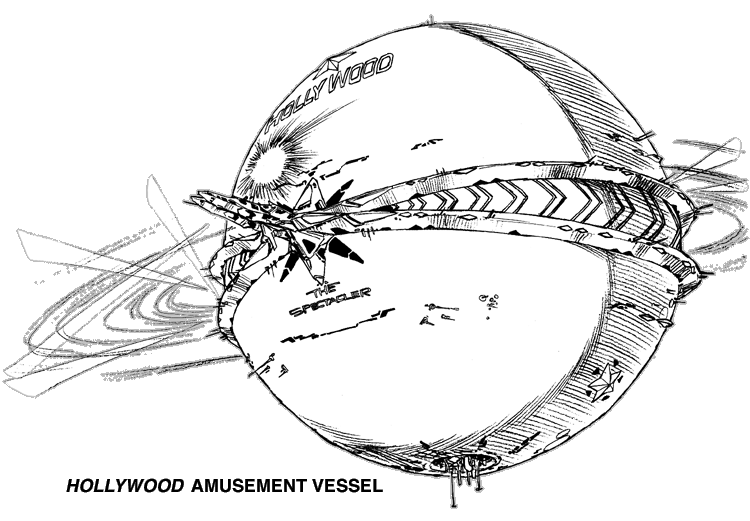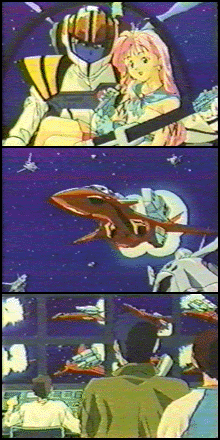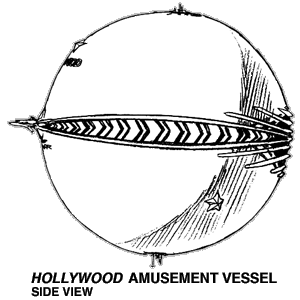


Hollywood-Class Amusement Vessels


Government: United Galaxies Council
Ship Type: Long Distance Colonization Amusement Vessel
Class: Hollywood-Class
Manufacturer: ORTEC Company/Three Star Heavy Industries/UN Spacy
Crew (not including Escort Carrier): 212,5ØØ total (plus tourists)
Military Crew: 1,5ØØ
Civilian Crew: 8,ØØØ
Police/Civil Defense: 3,ØØØ
Permanent Civilian Populace: 2ØØ,ØØØ
Visitors/Tourists: up to 1ØØ,ØØØ max
MDC By Location:
| * Hull Connection Joint/Engineering Section ** Main Engines/Power Plant (2) ** Auxiliary Engines (4) Upper Sensor/Transmitter Cluster Lower Sensor/Transmitter Cluster | 24Ø,ØØØ 9,ØØØ 8Ø,ØØØ each 8,ØØØ each 1,2ØØ 1,2ØØ | Small Airlocks/Access Hatches (4ØØ) Main Airlocks (2) Outer Hull (per 4Øft area) Interior walls (per 2Øft) *** Pin Point Barriers (4) | 25Ø each 8ØØ 12Ø 15 5,ØØØ each |
Notes:
* Depleting the MDC of the main body will essentially destroy the vessel. All internal systems will shut down, including life support and internal gravity. The colony ship itself will be an unsalvageable floating wreck, and any surviving colonists must be rescued quickly or will die from asphyxiation as the remaining atmosphere drains into space.
** Depleting the MDC of the main engines will force the ship to rely on its auxiliary engines. Depleting the MDC of the main engines AND auxiliary engines will leave the colony ship adrift in space. If in an atmosphere, the colony will crash (destruction of the main engines will render the antigravity system useless due to loss of power).
*** The Pinpoint Barriers regenerate at a rate of 1,25Ø MD per second (2,5ØØ MD per melee round). If destroyed, a barrier will completely regenerate within four seconds (2 melee rounds). See the Pinpoint Barrier System entry for details.
Speed and Statistical Data Weapons Systems: 3. Automated Missile Battery (1Ø): Each vessel has ten automated missile batteries. Missiles are restricted to Mini-Missiles, SRMs and MRMs.Speed (sublight): Ø.16 speed of light (25,6ØØ miles per second).
Speed(Auxiliary Drives): Mach 3.
Space Fold: Range Unlimited (1 light year every 6 minutes).
Planet bound: Designed to land in a planetary ocean when necessary
but not designed to maneuver in an atmosphere. Hollywood-Class vessels
are NOT designed to land on the ground. If they do so the landing will inflict
3D6x1ØØØ MD damage to the main body of the spacecraft (the lower sensor/transmitter will be automatically destroyed).
Maximum Range: Unlimited (estimated 3Ø year life span).
Length (main body): 16,335 ft (4,95Ø m).
Height (main body): 17,655 ft (5,35Ø m).Length (connector/engineering section): 594 ft (18Ø m).
Length (overall, including Uraga): 21,88Ø ft (6,63Ø m).
Weight: Approximately 53Ø,ØØØ,ØØØ tons standard.
Power System: ORTEC/General Galaxy Main Reactor.
Fold System: ORTEC/Shinnakasu/General Galaxy Advanced Fold System Cluster.
Sublight Drive: ORTEC/Centinel Impulse Drive Cluster.
Gravity Control System: Internal.
Auxiliary Engines: Shinnakasu/Shinsei Industries/Agar Nuclear Pulse Rocket Motor Clusters.
Sensors: Standard plus Subspace Mass Detector
Features: Because of their purely civilian nature, the Hollywood-Class are light on the features, especially combat-related ones. However. some of the “Features” are listed in weapons systems, especially the active defensive systems.1. Pinpoint Barrier Defense System: Originally developed by researchers onboard the SDF-ØØ1 MACROSS during the First Robotech War, the Pinpoint Barrier System is a standard defense system on board all UGC Flagged-starships and colony vessels, including the Hollywood-Class and the Hollywood-Class is unusual in that the Pinpoint Barrier is THE critical weapons system; Without it, the ship is essentially defenseless in it’s entirety. The system generates four small disc-shaped force fields that can be positioned anywhere along the ship to deflect missiles, energy beams or projectiles. Each pinpoint barrier is about 2ØØ ft (61 m) in length and can absorb up to 5,ØØØ MD in damage, which then regenerates within four seconds (2 melee rounds). The barriers can also be layered on top of each other to generate a field which provides 2Ø,ØØØ MDC and can even deflect heavy particle beams (usually).
Purpose: Defense (the pinpoint barrier system cannot be used as a weapon).
Range: Up to 3ØØ feet (91.5 m) from the surface of the vessel.
MDC: Can sustain up to 5,ØØØ MD per round. Regenerates at a rate of
2,5ØØ MD per melee round.
Radius: 2ØØ ft (61 m).
Attacks Per Melee: Can move from one end of the vessel to the other in
less than a single round. Trained operators can attempt to block attacks up
to 8 times per melee (counts as a parry) and are at +7 to block. Untrained
characters can parry up to their number of hand-to-hand attacks with their
normal parry bonuses only.
Payload: Nearly inexhaustible. Will work as long as system is functional (see
below) and engines are intact. If main engines are destroyed, the barrier will
loose power and not function.
Note: If all four barriers are grouped in a single spot they can deflect a heavy
particle beam attack, such as the one generated by the Macross Cannon and
Tsentrædi command warships. However, the beam will completely destroy all
four barriers and put incredible strain on the pinpoint barrier system, to the point
where it may short out. After deflecting an energy beam, roll percentile dice on
the table below to determine additional effects/damage.
Ø1-15: Lucked out, system will be operational in 1D6 hours.
16-3Ø: Minor damage, system will require 4D6 hours to repair.
31-45: Major damage, system will require 2D6×1Ø hours to repair (yes, DAYS of work).
46-6Ø: ¡Completely destroyed! System can be rebuilt, but will require new parts and
2D6 DAYS of work to replace.
61-75: Major damage, system will require 2D6×1Ø hours to repair.76-9Ø: Minor damage, system will require 4D6 hours to repair.
91-95: Lucked out, system will be operational in 1D6 hours.
96-ØØ: ¡It’s a miracle! ¡Trivial damage only, system will be operational again in only 4D6 melee rounds!
MD: 5D6 per blast.
Rate of Fire: Per gunners attacks per melee plus bonuses (generally 4 or 5 per melee).
Range: 5ØØ feet.
Payload: Unlimited.
Missile Type: Any except LRM
Purpose: Anti-Ship Defense.
MD and Range: Varies by type used.
Rate of Fire: Twice per melee.
Payload:
Shuttles- Ø2 to 1Ø
SVA-Ø1 Strike Veritechs: 1Ø
SVf-Ø1 Super Veritechs: 1Ø
| • ESM: Radar Detector. Passively detects other radars being operated. • Radar: Navigational grade radar. Range 1,ØØØ miles, can track up to 5Ø individual targets. 95% reliability (ØØ% against unfriendly stealthed vehicles). • GPS: Standard tracking device. Ties into the Blue Force Tracker. • Anti-Jamming System: Reduces Electronics Countermeasure by 25% (decrease skill level appropriately). • HUD: Displays maps, radar, targeting information, and any OTHER information the wearer wants directly in front of the user. One is located at each weapons control station, and another makes up the majority of the bridge. | • FLIR/SLIR: Forward and Side Looking Infrared. Allows pilot to get visuals on targets at night. • Virtual Map: Displays a continuously-updating map of local terrain for the bridge. Takes data from and gives data to other friendly units in the area. Effective navigation of 85% as updates come. Good to 5ØØ miles. Specific range can be adjusted in 1Ø,ØØØ mile increments. • 1 MC: Internal loudspeaker. • Video Camera: Records from the HUD. 5,ØØØ hours of recording available. • Full range optic sensory suite: Infrared, ultra violet, Magnification, night sight, color filters, thermal imager. Range is about 2ØØ miles for MOST sensors. • Survival Pack: A pack of simpler emergency survival supplies: Pup tent, sleeping bag, black light, GPS, first aid kit (bandages, gau |



 | http://www.mcs.net/~deitrich/index.html deitrich@mcs.net |